
Parisian Illuminator
Leaf from a Book of Hours, with a marginal painting of a Horse, saddled and harnessed
Written in Latin, from the Office of the Dead, text continues Psalm 7,… meam in pulverem deducat (… lay my glory in the dust)
France, Paris, circa 1290-1300
Overall dimensions, 137 × 84 mm
Tempera, ink and gold on parchment
$5,500
This leaf comes from an extremely early French Book of Hours and is distinguished by whimsical line-fillers and a delightfully painted marginal horse. Saddled and harnessed, with its bridle, straps, and tack carefully detailed, the tiny figure charges into the text with striking energy—an unusual and charming feature for a manuscript of this date, and all the more remarkable for the extraordinary detail lavished on so small a motif. Painted by a Parisian illuminator at a time when Paris stood at the very center of luxury manuscript production in Europe, the leaf embodies the refinement and inventive spirit that made Parisian Books of Hours prized across the continent.
The page is laid out in twenty lines of text in a fine early gothic hand, written in dark brown ink with versal initials alternately in red or blue with contrasting penwork, and one illuminated initial in gold and blue. Rubrics are in red. Decoration includes seven distinct line-fillers: one a bird, another a fantastical beast, the others geometric. These whimsical details, set against the solemn text of the Office of the Dead, highlight the wit and imagination of early Parisian illuminators and scribes.
On the verso, below the main text, later inscriptions add further interest. A line of neumatic music notation is visible, with the words partly legible as “… sum ego ipse et non alius, et oculi mei conspectu …” The first word is rubbed and uncertain. Whether this is a fragment of a hymn or a later devotional addition remains open, but its presence speaks to the manuscript’s long devotional afterlife particularly in the 17th century, when the parent volume was owned by the priest Jacobus Castellus of Gruyère, Switzerland. Above the initial P is another inscription, likely in Castellus’s hand, now largely illegible but offering yet another trace of the manuscript’s centuries of use.
PROVENANCE
1. From a fragmentary parent manuscript of 72 leaves, sold at Sotheby’s, 5 December 1989, lot 104.
2. Recorded ownership by Jacobus Castellus, priest in Gruyère, Switzerland, gifted by his father Franciscus Castellus, 1 August 1619.
3. Later in the library of Matias Errázuriz (1897–1941), the noted Argentine bibliophile and collector.
4. Dr. Edwin E. Gordon (1927–2015), Madison, WI, eminent music educator and collector of medieval manuscripts.
LITERATURE
Roger S. Wieck, Time Sanctified: The Book of Hours in Medieval Art and Life. New York: George Braziller, 1988.
Michael Camille, Image on the Edge: The Margins of Medieval Art. Cambridge, Mass.: Harvard University Press, 1992.
Eric Palazzo, A History of Liturgical Books from the Beginning to the Thirteenth Century. Collegeville, MN: Liturgical Press, 1998.
Roger S. Wieck, “The Death Desired: Books of Hours and the Office of the Dead” in Death and Dying in the Middle Ages, ed. Edelgard E. DuBruck & Barbara I. Gusick. New York: Peter Lang, 1999.



